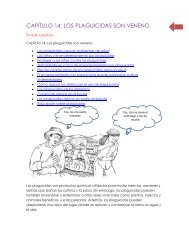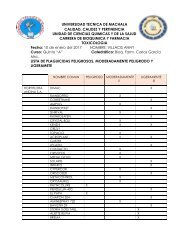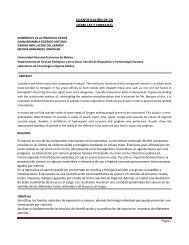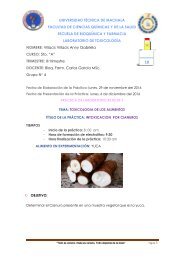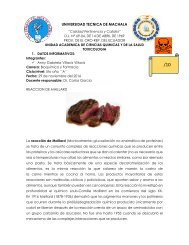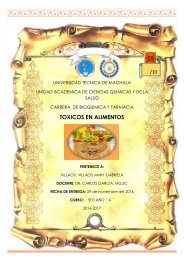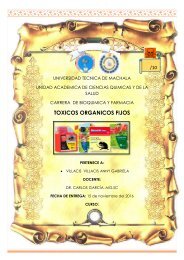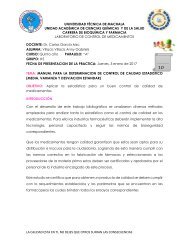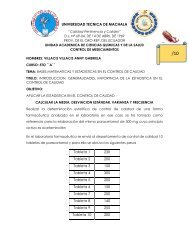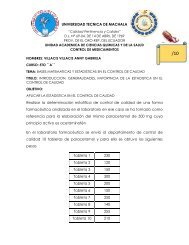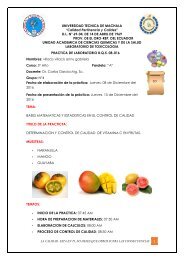You also want an ePaper? Increase the reach of your titles
YUMPU automatically turns print PDFs into web optimized ePapers that Google loves.
38 Junqueira et al.<br />
Table 3. Carcass characteristics (carcass, breast, thigh and drumstick, wing and back yield) of male broiler chicks from 22 to 42 days of<br />
age treated with different levels of sodium gluconate.<br />
Variable (%) 1 Sodium gluconate levels (%)<br />
CV<br />
0.00 0.10 0.20 0.30 0.40 (%)<br />
Regression<br />
Carcass yield 73.69 74.08 77.65 74.96 76.49 4.78 NS<br />
Breast Yield 2 39.17a 38.31a 37.35b 37.77ab 37.37a 3.75 *<br />
Thigh and Drumstick Yield 29.37 29.56 29.42 30.12 29.57 4.99 NS<br />
Wing Yield 10.38 10.39 10.31 10.23 9.96 4.70 NS<br />
Back Yield 20.64 22.37 21.05 22.42 21.11 4.64 NS<br />
*Quadratic effect (p < 0.05). 1 Each mean represents 8 replications with 8 broilers each. 2 Ŷ = 39.373-23.261x+53.224x 2 ; r 2 = 0.70.<br />
Table 4. Morphometric characteristics (villus height, crypt depth, and villus height crypt -1 depth ratio) of duodenum, jejunum and ileum<br />
from male broilers at 42 days of age, treated with different levels of sodium gluconate.<br />
Variable 1 Sodium gluconate levels (%) CV<br />
Duodenum 0.00 0.10 0.20 0.30 0.40 (%)<br />
Regression<br />
Villus Height (μm) 2 1618.7 1512.8 1429.3 1608.1 1478.7 12.67 *<br />
Crypt Depth (μm) 3 251.07 233.37 290.33 298.89 300.79 17.05 *<br />
Villus Height Crypt -1 Depth Ratio (μm) 4 6.58 6.53 5.16 5.38 4.92 17.50 **<br />
Jejunum<br />
Villus Height (μm) 1158.5 1231.6 1323.8 1091.6 1124.5 11.12 NS<br />
Crypt Depth (μm) 5 190.45 193.49 247.43 276.87 257.51 21.58 **<br />
Villus Height Crypt -1 Depth Ratio (μm) 6 6.39 6.44 5.43 4.02 4.43 18.71 **<br />
Ileum<br />
Villus Height (μm) 812.8 714.3 751.5 856.7 797.2 17.48 NS<br />
Crypt Depth (μm) 224.67 197.26 225.58 300.89 236.97 17.65 NS<br />
Villus Height Crypt -1 Depth Ratio (μm) 3.73 3.72 3.35 2.88 3.55 27.24 NS<br />
*Quadratic effect (p < 0.05), **Linear effect (p < 0.05). 1 Each mean represents 8 replications with 2 broilers each. 2 Ŷ = 1813.19-242.85x-44.10x 2 ; r 2 = 0.82. 3 Ŷ = 178.36+65.91x-<br />
8.23x 2 ; r 2 = 0.48. 4 Ŷ = 7.059-0.448x; r 2 = 0.81.<br />
Poeikhampha and Bunchasak (2010) concluded<br />
that sodium gluconate supplementation as prebiotic is<br />
beneficial because this additive is the main substrate<br />
used by saprophyte bacteria for butyrate production in<br />
poultry and swine. Ribeiro et al. (2002) affirmed that<br />
viable cells (probiotics) compete with pathogenic<br />
microorganisms for a location to attach to the intestinal<br />
mucosa, decreasing the incidence of diarrhea and<br />
improving the absorption of available nutrients. This<br />
mechanism has direct influence on the reestablishment<br />
of intestinal mucosa, increasing villus height.<br />
Crypt depth increased (p < 0.05) (Ŷ = 167.90 +<br />
21.75x; r 2 = 0.83), and the villus:crypt ratio<br />
decreased (p < 0.05) linearly (Ŷ = 7.25 - 0.63x;<br />
r 2 = 0.82) in the jejunum portion for higher levels of<br />
sodium gluconate. These results are in disagreement<br />
with Oliveira et al. (2009), who did not observe any<br />
effect of mannan oligosaccharide and enzymatic<br />
complex addition on villus height and crypt depth of<br />
jejunum. Likewise, Schwarz et al. (2002) compared<br />
the effect of diets with and without antibiotics, and<br />
with fructooligosaccharide (0.2%) and mannan<br />
oligosaccharide (0.2%), and did not detect significant<br />
differences in duodenum villus height and crypt<br />
depth.<br />
The different levels of sodium gluconate did not<br />
cause significant effect on ileum morphometry of<br />
broilers at 42 days of age (Table 4).<br />
Conclusion<br />
The use of sodium gluconate until the level of<br />
0.4% did not affect the performance of broilers from<br />
22 to 42 days of age. Moreover, the inclusion of<br />
sodium gluconate caused no effect on carcass<br />
characteristics, but improved the morphometric<br />
characteristics of the duodenum and jejunum.<br />
Acknowledgements<br />
This research was supported by Sumitomo<br />
Chemical, São Paulo State, Brazil.<br />
References<br />
ALBINO, L. F. T.; FERES, F. A.; DIONIZIO, M. A.;<br />
ROSTAGNO, H. S.; VARGAS JÚNIOR, J. G.;<br />
CARVALHO, D. C. O.; GOMES, P. C.; COSTA, C. H.<br />
R. Uso de prebióticos à base de mananoligossacarídeo em<br />
rações para frangos de corte. Revista Brasileira de<br />
Zootecnia, v. 35 n. 3, p. 742-749, 2006.<br />
ASANO, T.; YUASA, K.; KUNUGITA, K.; TERAJI, T.;<br />
MITSUOKA, T. Effects of gluconic acid on human faecal<br />
bacteria. Microbial Ecology in Health and Disease,<br />
v. 7, n. 5, p. 247-256, 1994.<br />
ASANO, T.; YUASA, K.; YOSHIMURA, Y.;<br />
TAKENAWA, S.; FUKUBA, H. Digestion, absorption<br />
and intestinal residue of various gluconic acids in rats.<br />
Journal of Japanese Society of Nutrition and Food<br />
Sciences, v. 50, n. 4, p. 287-294, 1997.<br />
CAMPBELL, J. M.; FAHEY JÚNIOR, G. C.; WOLF, B.<br />
W. Selected indigestible oligosaccharides affect largebowel<br />
mass, cecal and fecal shortchain fatty acids, pH and<br />
microflora in rats. The Journal of Nutrition, v. 127,<br />
n. 1, p. 130-136, 1997.<br />
D’ARGENIO, G.; COSENZA, V.; <strong>DE</strong>LLE CAVE, M.;<br />
IOVINO, P.; <strong>DE</strong>LLE VALLE, N.; LOMBARDI, G.;<br />
MAZZACCA, G. Butyrate enemas in experimental colitis<br />
Acta Scientiarum. Animal Sciences Maringá, v. 34, n. 1, p. 35-40, Jan.-Mar., 2012






